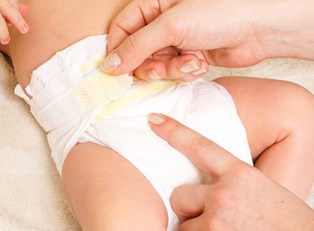Diaper rash is a relatively common form of skin inflammation and irritation found in the areas of skin covered by diapers. In general, the rash appears red and may cover large or small areas of the buttocks, hips, and sometimes thighs. The rash has many potential causes that range from humidity to dietary changes to allergic reactions. Most cases get better through at-home care and rarely require the intervention of a physician, except in severe or highly recurrent cases.
What causes a diaper rash?
Causes can be related to numerous factors in the daily lives of infants, including their environment, hygiene, diet, medications, and allergies. Some of these can influence each other to create a greater likelihood of the rash occurring or a more severe case.
Environmental causes are primarily high humidity and heat, in combination with restrictive clothing, such as plastic pants or clothing too warm for the ambient temperature. Causes relating to hygiene include not changing the diaper frequently enough, insufficient wiping up after defecation or urination, or using sanitary products too harsh for an infant's skin.
Dietary causes of diaper rash include changing from milk or formula to solid foods, having food-related diarrhea, or toxins in breast milk from medication or consumption of certain foods by the mother. Medications, such as antibiotics, and allergens can also cause diaper rash. Antibiotics are the most common medication to blame for infant rashes because of the effect they have on the immune and digestive systems.
Allergens can come from foods, the environment, or even wipes, lotions, or powders used topically. If you are certain the rash originates from an allergen, you may choose to seek medical advice, as the allergy could be severe or life-long. If you cannot pinpoint the allergy source or if the severity of the rash causes concern, you may wish to consult an allergist.
How can diaper rashes be avoided?
Avoiding diaper rashes entirely is a laudable goal; however, most infants experience some degree of diaper rash during their early years. Minimizing or avoiding rashes with a known cause is more manageable.
In terms of avoiding environment causes, parents should take care not to allow their child to sweat too much or be over-dressed in humid conditions. Additionally, changing soiled diapers quickly can be helpful, especially if the infant has diarrhea or is undergoing dietary changes. Allergen-free powder can help with keeping the skin dry and comfortable, too.
Avoiding allergens as much as possible is advised, especially if parents have determined the cause of the rash. If a medication seems to be the problem, contact your pediatrician to discuss your concerns. He or she may have an alternative form of treatment available.
Diaper rash can cause concern for parents and some discomfort for the infant, but overall, this condition is common and can generally be treated at home with common sense and over-the-counter remedies. Determining and managing the cause are key ways to minimize and avid future outbreaks of diaper rash.



